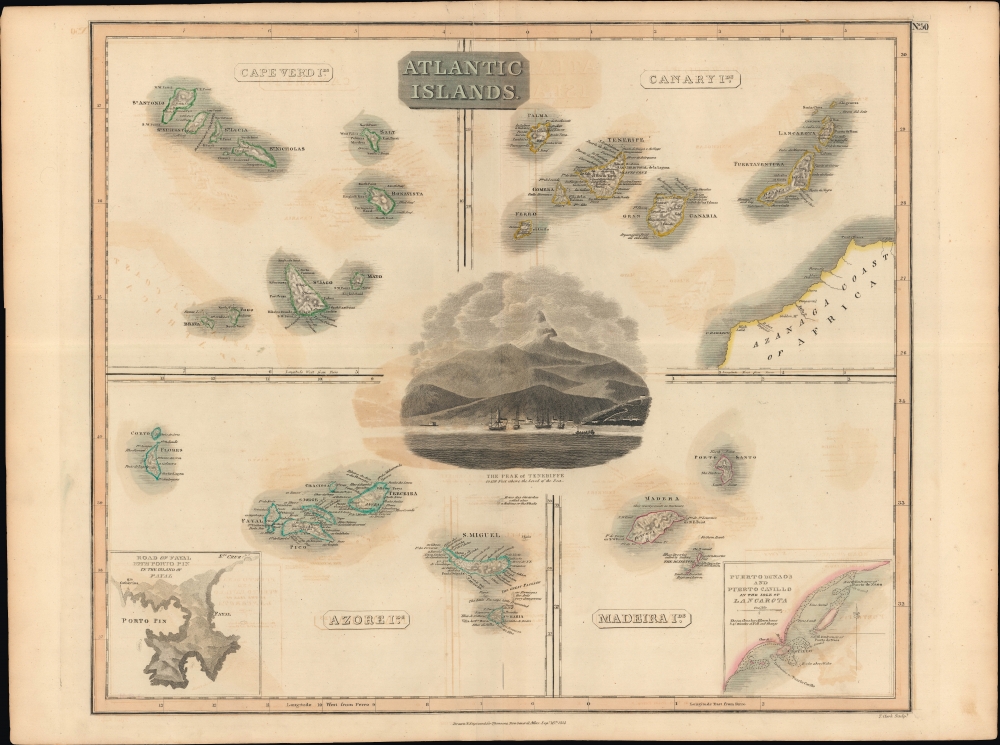This item has been sold, but you can get on the Waitlist to be notified if another example becomes available, or purchase a digital scan.
1814 Thomson Map of Atlantic Islands: Cape Verde, Canary, Madeira, Azores
AtlanticIslands-thomson-1814-2
Title
1814 (dated) 20.25 x 24 in (51.435 x 60.96 cm)
Description
A Closer Look
A large central graphic depicts Tenerife, the largest of the Canary Islands. Clockwise from top-right, the Canary Islands, Madeira Islands, Azores, and Cape Verde Islands are similarly displayed, with an emphasis on settlements, mountains, and waterways. An inset at bottom-right displays Puerto de Naos and Puerto Cavallo while one at bottom-left depicts Porto Pim on Fayal.These islands were crucial in the 15th and 16th centuries as stepping stones to the exploration of the New World. The Portuguese, in particular, mastered methods of navigation and tested out means of economic exploitation on the islands, including monocrop plantations worked by slave laborers from western Africa. By the 19th century, however, these islands were absorbed by Britain's preponderant naval and economic power, becoming a vacation destination and source of luxury goods such as Madeira wine. In the early 19th century, Tenerife loomed heavy in the minds of the British, whose national hero, Admiral Horatio Nelson, died in a bold 1787 attempt to seize it.
The whole is beautifully engraved in the minimalist Brittish style pioneered in the early part of the 19th century. Thomson maps are known for their stunning color, awe inspiring size, and magnificent detail. Thomson's work, including this map, represents some of the finest cartographic art of the 19th century. Relief is shown by hachure with towns, cities, and major topographical features identified.
Publication History and Census
This map was prepared by John Thomson and engraved by Thomas Clerk in 1814 for inclusion in Thomson's New General Atlas, which went through multiple printings in both Dublin and Edinburgh. Examples of the map display different pagination (or none at all) depending on the printing, with the plate number here (No. 50) seemingly added separately from the main plate, different from another example previously sold by us as well as that held by the David Rumsey Historical Map Collection.CartographerS
John Thomson (1777 - c. 1841) was a Scottish cartographer, publisher, and bookbinder active in Edinburgh during the early part of the 19th century. Thomson apprenticed under Edinburgh bookbinder Robert Alison. After his apprenticeship, he briefly went into business with Abraham Thomson. Later, the two parted ways, John Thomson segueing into maps and Abraham Thomson taking over the bookbinding portion of the business. Thomson is generally one of the leading publishers in the Edinburgh school of cartography, which flourished from roughly 1800 to 1830. Thomson and his contemporaries (Pinkerton and Cary) redefined European cartography by abandoning typical 18th-century decorative elements such as elaborate title cartouches and fantastic beasts in favor of detail and accuracy. Thomson's principle works include Thomson's New General Atlas, published from 1814 to 1821, the New Classical and Historical Atlas of 1829, and his 1830 Atlas of Scotland. The Atlas of Scotland, a work of groundbreaking detail and dedication, would eventually bankrupt the Thomson firm in 1830, at which time their plates were sequestered by the court. The firm partially recovered in the subsequent year, allowing Thomson to reclaim his printing plates in 1831, but filed again for bankruptcy in 1835, at which time most of his printing plates were sold to A. K. Johnston and Company. There is some suggestion that he continued to work as a bookbinder until 1841. Today, Thomson maps are becoming increasingly rare as they are highly admired for their impressive size, vivid hand coloration, and superb detail. More by this mapmaker...
Thomas Clerk (March 30, 1779 - January 1, 1861) was a Scottish engraver active in Edinburgh in the early part of the 19th century. Clerk engraved extensively for John Thomson and Thomas Brown, among others in a career spanning nearly 50 years. Learn More...

